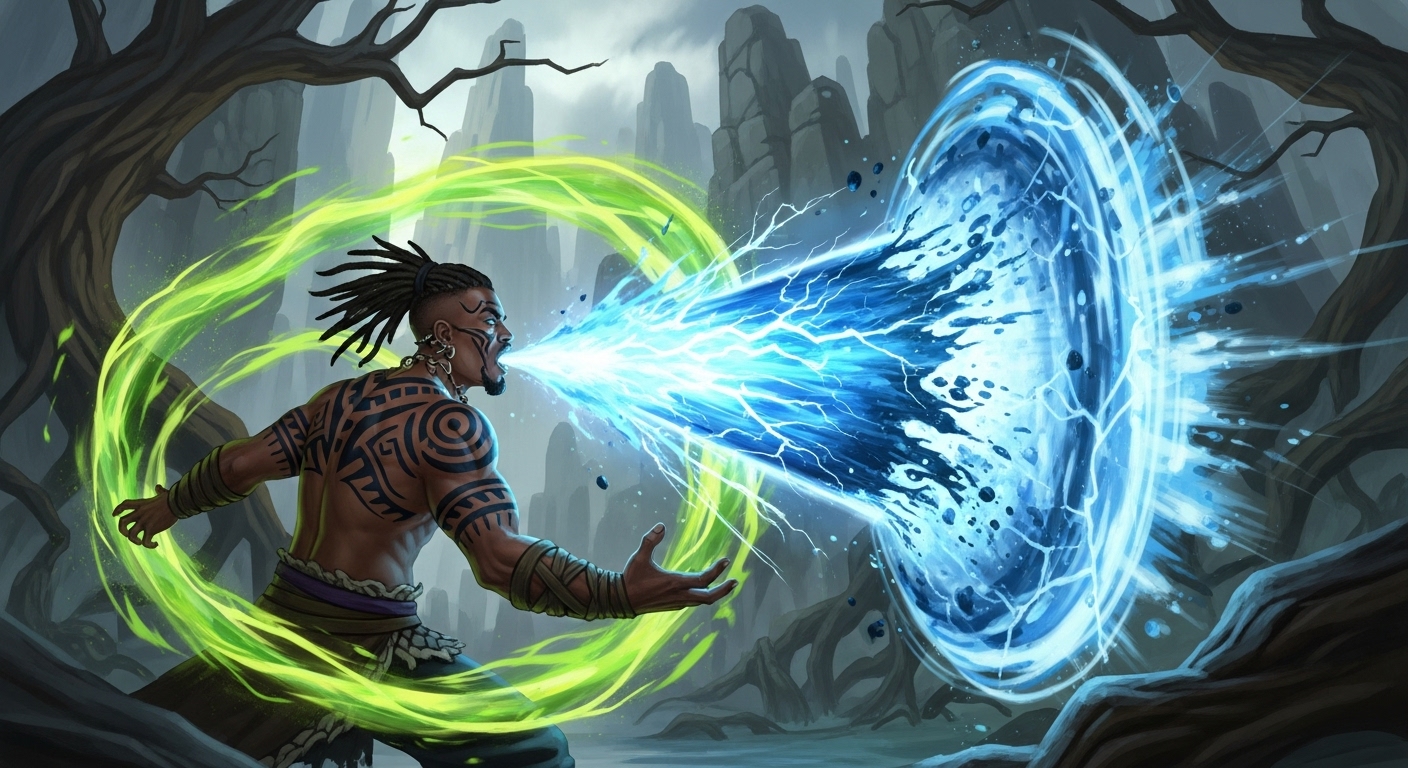Dragon'S Breath

- Level: 2
- School: Transmutation
- Class: Sorcerer, Wizard
- Casting Time: Bonus Action
- Range: Touch
- Components: V, S, M (a hot pepper)
- Duration: Concentration, up to 1 minute
You touch one willing creature, and choose Acid, Cold, Fire, Lightning, or Poison. Until the spell ends, the target can take a Magic action to exhale a 15-foot Cone. Each creature in that area makes a Dexterity saving throw, taking 3d6 damage of the chosen type on a failed save or half as much damage on a successful one.
Using a Higher-Level Spell Slot. The damage increases by 1d6 for each spell slot level above 2.
Tactical Usage
Elemental Empowerment: Dragon's Breath grants creatures devastating breath weapon attacks. This 2nd-level transmutation spell excels at providing area damage capabilities to non-dragon creatures.
Optimal Timing: Cast on allies before combat, when facing grouped enemies, or when consistent area damage is needed.
Resource Management: Uses a 2nd-level spell slot - available from character level 3+. 1-minute concentration provides sustained breath attack capability.
Target Selection: One willing creature within touch range gains draconic breath weapon.
Spell Combinations
Synergistic Spells:
- Enhancement Magic: Combine with enlarge/reduce for improved breath weapon range
- Protection Magic: Layer with shield or counterspell to protect breath weapon users
- Area Control: Pair with other area effects for comprehensive battlefield coverage
Class Feature Interactions:
- Draconic Bloodline: Sorcerers gain thematic connection to dragon magic
- Metamagic: Sorcerers can extend range or apply other enhancements to breath weapons
- Fighting Styles: Combat-focused features enhance breath weapon tactical usage
Multi-Caster Coordination: Multiple dragon's breath effects can provide overlapping area coverage.
Material Component Details
Component Acquisition: Hot pepper - common culinary ingredient easily obtained from markets or grown.
Component Handling: Simple material component representing elemental fire and draconic power.
Roleplay Opportunities: Different pepper varieties might influence breath weapon intensity or elemental flavor.
Economic Considerations: Minimal component costs make this economically viable for regular combat enhancement.
Creator Notes
Encounter Balancing: Area damage capability granted to non-casters affects encounter balance, especially for companions.
NPC Usage: Familiar users, beast masters, or summoning specialists might enhance their creatures with breath weapons.
Environmental Considerations: 15-foot cone provides substantial area coverage for tactical positioning.
Campaign Integration: Excellent utility magic for enhancing non-combat creatures or providing area damage options.
Environmental Interactions
Terrain Effects: 15-foot cone area adapts to terrain features. Can target around corners with proper positioning.
Weather Influence: Elemental breath weapons generally unaffected by weather conditions.
Structural Interactions: Breath weapons can affect multiple targets behind partial cover.
Elemental Interactions: Different damage types (acid, cold, fire, lightning, poison) interact with creature resistances.
Common Rulings & Clarifications
Timing Questions: Action casting time with 1-minute concentration. Target can use breath weapon as action.
Target Limitations: One willing creature within touch range. Creature gains breath weapon for duration.
Duration Interactions: Concentration required. Breath weapon recharges on 6 each round after use.
Mechanical Interactions: 3d6 base damage, +1d6 per slot level above 2nd. Dexterity save for half damage.
Alternative Applications
Non-Combat Uses: Intimidation displays, performance art, environmental modification, or demonstration of draconic power.
Social Encounters: Dramatic demonstrations, intimidation tactics, or displaying magical enhancement capabilities.
Exploration Applications: Clearing obstacles, environmental modification, or accessing areas requiring elemental effects.
Utility Functions: Environmental tools, intimidation assistance, elemental utility, or draconic roleplay enhancement.
Related Spells
Same School: Other transmutation spells like alter self (2nd level form change), polymorph (4th level creature transformation), true polymorph (9th level permanent change).
Similar Effects: burning hands (1st level fire cone), dragon's breath (2nd level granted breath), fireball (3rd level fire area damage).
Progression Options: burning hands (1st level personal cone), dragon's breath (2nd level granted breath), cone of cold (5th level advanced cone).
Complementary Magic: find familiar (targets for breath weapons), enlarge/reduce (size modification), haste (additional actions).
Scaling Analysis
Level Progression: Remains valuable throughout campaigns for providing area damage to non-caster allies.
Upcast Benefits: Additional 1d6 damage per slot level above 2nd significantly improves effectiveness.
Campaign Phases: Most effective in early-to-mid level play where area damage is crucial tactical advantage.
Comparative Value: Excellent utility magic for enhancing party capabilities, especially familiar users or beast companions.
Narrative Flavor
Casting Description: Draconic energy flows into the target as their throat and chest adapt to channel elemental breath weapons.
Effect Manifestation: The enhanced creature gains the ability to exhale devastating elemental energy in draconic breath weapon form.
Personal Style: Sorcerers manifest inherited draconic power, while wizards grant calculated elemental transformation through transmutation magic.
World Integration: Represents draconic magic adaptation available to various casters, often associated with dragon magic traditions, elemental specialization, or creature enhancement techniques.